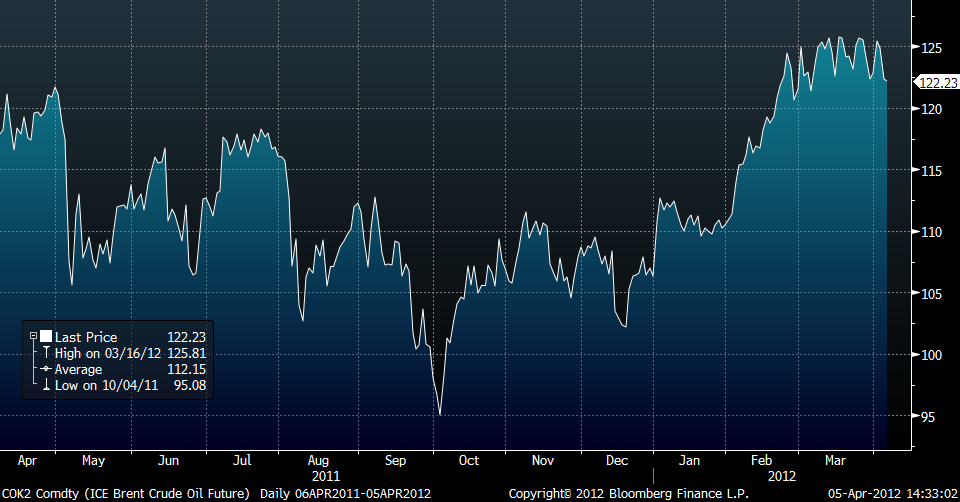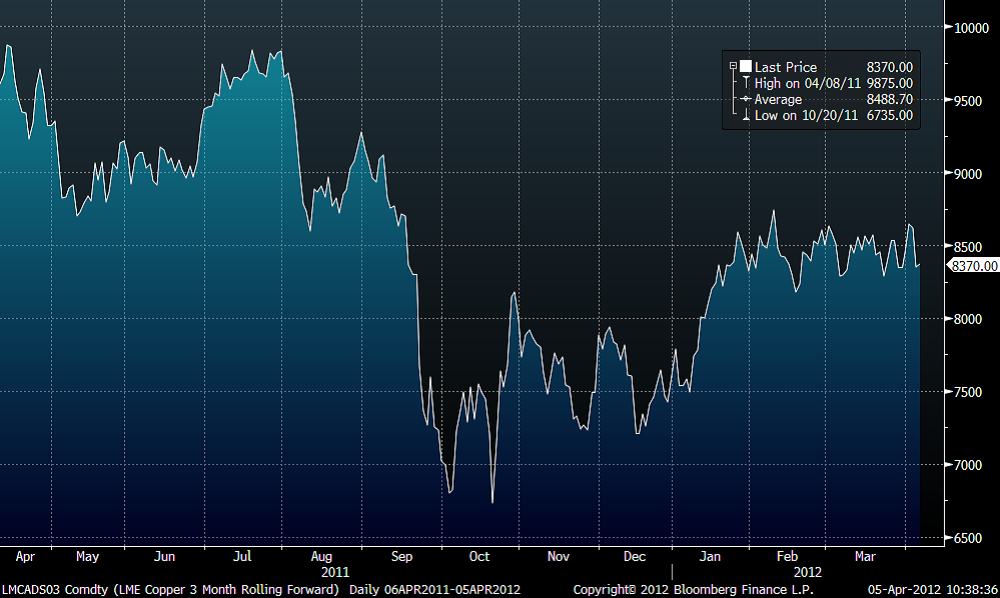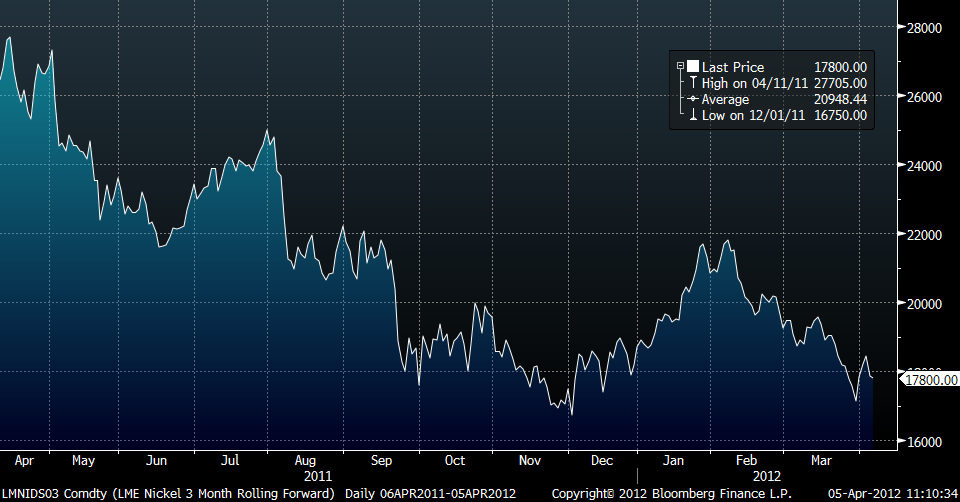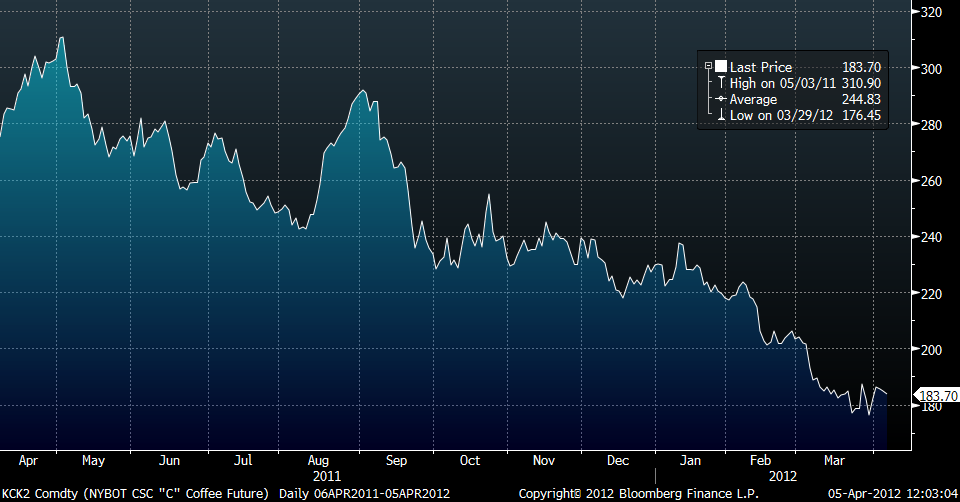Analys
SHB Råvarubrevet 5 april 2012
- Energi: Positiv
- Basmetaller: Neutral
- Ädelmetaller: Negativ
- Livsmedel: Neutral till Positiv
Risktillgångar har haft en blandad utveckling senaste veckan. Kinafrossan dämpades något av veckans inledande inköpschefsindex från Kina som för en statistiskt svår månad visade på en uppgång från februari. Shanghai-börsen pekar dock fortfarande rakt ner (-7 % i mars). Efter att USA:s dito data kom in på hyggliga nivåer i måndags blev det åka av och både basmetaller och Brent handlades upp kraftigt under några timmar. Fortfarande ligger dock dessa konjunkturhandlade råvaror kvar i sina respektive handelskanaler där koppar skvalpat omkring sedan januari och Brent sedan slutet av februari när Iran-oron började.
I Europa har italienska och spanska statsobligationer gått sämre än de tyska vilket indikerar att det mesta av effekten från ECBs aktion för likviditet, LTRO2 nu ligger bakom oss. Vi befinner oss fortfarande i en miljö som är positiv för risktillgångar. Ekonomer höjer prognoserna för global BNP och analytiker hissar upp estimat för bolagsvinster.
Protokollet från senaste mötet för Amerikanska centralbanken Fed kom i veckan och där tonades behoven av ytterligare stimulans (QE3) ned. Som tidigare under året så tappade guld och silver (-2 %) på beskedet om utebliven QE3. Vår uppfattning är att det inte kommer mer USA-stimulans om inte den amerikanska ekonomin avsevärt försämras.
Energi (positiv)
Olja
Oljepriset är tillbaka på samma nivå som vid öppningen i måndags, Brent-oljan handlas nu till 122 USD/fat men har toppat veckan på nästan 126 USD/ fat efter positiv data från Kina och USA. Oljan handlades dock ned igen efter FED:s räntemöte och ytterligare prispress under gårdagen då lagernivåer visade på stigande lagernivåer. Analytiker förväntade sig att se de amerikanska råoljelager att öka med 2,5 miljoner fat men fick se lagren öka med 9 miljoner fat! Även destillat lager översteg förväntningarna, upp 19 000 fat mot förväntade 500 000 fat medan bensinlager sjönk med 1,5 miljoner fat mot förväntade 1,4 miljoner. Fortsatt oro kring det politiska läget i Iran håller priset uppe och ger få säljare i marknaden. Vi ser en risk på uppsidan och behåller därför en positiv syn på oljan.
Elmarknaden
Variationer i väderprognoser tillsammans med låg likviditet till följd av påskledighet har lett till en hel del prisrörelser på elmarknaden. Kontraktet Q3-12 (som är underliggande till SHBPOWER) hade vid lunchtid idag stigit med 6,7 % från måndagens öppning. Det har egentligen inte funnits mycket som talat för en uppgång, med både svaga gas- och CO2 priser och lägre tyska priser. Med låg likviditet reagerade marknaden kraftigt då en torrare och kallare väderprognos presenterades i mitten av veckan. Väderprognoser har sedan dess visat på både mildare väder och med energileveranser över det normala . Vi kan konstatera att osäkerheten i prognoserna är stor och med svaga priser på utsläppsrätter och gas finns det inte mycket som talar för någon kraftig uppgång på kort sikt och behåller därför vår neutrala syn.
Basmetaller (neutral)
Koppar
Koppar har haft en volatil vecka. Metallen var upp som mest 2.3% för att sluta veckan på en total nedgång på 1 %. Uppgången sedan årets början är 7.3 %. Den dåliga spanska obligationsmissionen låg bakom den kraftiga nedgången i mitten av veckan. Priset återhämtade sig dock under torsdagen på rykten om en mindre stram kinesisk penningpolitik. Premiärminister Wen Jiabao sade i en intervju att Kina planerar justeringar av penningpolitiken ”inom en snar framtid”. Marknaden verkar vara i balans på utbuds- och efterfrågesida. Lagernivåerna hos LME är fortfarande låga men det motsvaras av ökade lager i Shanghai. Lagernivåerna i Kina har alltid varit problematiska att uppskatta, men vi anser att de senaste estimaten är någorlunda korrekta och därför är vi neutrala till kopparpriset.
Nickel
Nickel har klarat sig bra prismässigt denna vecka. Uppgången slutade på 3.6%, trots de dåliga nyheterna från Spanien. Nickel har dock totalt sett haft en dålig start på året med en nedgång 5.8%. Det som gav nickel kraftfullt stöd under veckan var oron om nya skatter på exporten från Indonesien. Tittar vi på hur kostnadsstrukturen ser ut för produktionen, så domineras högkostnadsproduktionen av producenter i Kina. Vid dessa prisnivåer kommer de gruvor att stänga ned eller producera mindre och på så sätt stödja priset. Vi ser inga betydande risker på upp- eller nedsidan och vi är neutrala till nickelpriset för tillfället.
Ädelmetaller (negativ)
Vi behåller vår negativa syn på ädelmetaller, vi lägger en stökig vecka till handlingarna, med börsfall och förnyade orostendenser. Trots det har ädelmetallerna fallit mellan 1,5 och 2,2 %, och guldet hänger strax över 1600 dollar per uns.
”Säker hamn”-temat och tendensen att köpa guld när börserna faller har falnat rejält som prisdrivande faktorer, och vi befinner oss på känsliga prisnivåer i alla ädelmetaller.
Det vi håller koll på framöver är om vi ser mer starka USA-data, parat med låg inflationsstatistik, som en potentiell trigger för en större rörelse nedåt i framför allt guldet.
Livsmedel (neutral till positiv)
Vete
Terminspriser på vete har i veckan gått ned i både Paris och Chicago, påverkat av bättre väder i både USA och Europa. I USA uppges nederbördsmängden generellt sett vara tillräcklig och i EU är det främst i Frankrike som regnmängderna fortfarande ligger något under normalt. Kommande väderutveckling i EU ser dock något osäker ut med varierande prognoser och viss oro finns över att resten av april inte riktigt ger den nederbördsmängd som önskas. I både Ryssland och Ukraina uppges vädret vara klart gynnsamt för höstvetet och även för sådd av vårgrödorna.
Skicket på det amerikanska höstvetet är relativt bra med 58 procent i bra eller utmärkt skick och endast 12 procent i riktigt dåligt skick – att jämföra med 37 procent respektive 32 procent vid samma tid förra året. Sådden av vårvete i USA går snabbt framåt och hela 8 procent av sådden uppges nu vara avklarad, klart mer än 1 procent vid samma tid förra året och femårsgenomsnittet om 2 procent. Aktiviteten på exportmarknaden har saktat in något delvis som följd av att de nordafrikanska länderna närmar sig skörd. Prisutvecklingen under den närmaste tiden är svårbedömd och starkt beroende av den fortsatta väderutvecklingen i främst EU och USA och dess effekt på höstgrödorna och den pågående sådden av vårgrödorna. I nästa veckas rapport från det amerikanska jordbruksdepartementet, USDA, väntas inga större förändringar vad gäller vetet.
Majs
Majsen i Chicago har stigit något i pris under veckan, påverkat av stigande priser på sojabönor vilket stärker konkurrensen om arealen i USA. Sådden har startat väl i USA med varmt väder och generellt sett lagom med regn och 3 procent av sådden uppges vara avklarad, något över förra året och de senaste fem åren vid denna tid om 2 procent. Den närmaste tiden kan nog bli lite skakig beroende på väderleken i USA och även beroende på nästa veckas WASDE-rapport från USDA – i vilken siffrorna för den sydamerikanska skörden väntas bli nedjusterade. Förutsatt att vädret inte bjuder på alltför stora överraskningar bör en stor amerikansk majsareal leda till förbättrad lagersituation längre fram på året.
Sojabönor
Sojapriserna i Chicago har fortsatt att stiga i pris under veckan, förra veckans rapport från det amerikanska jordbruksdepartementet, USDA, visade att priserna måste upp ytterligare för att hushålla med nuvarande lager och för att öka arealen under våren i USA. Sojapriserna är nu så
mycket högre än majspriserna så att det vore mer lönsamt att odla soja i flera regioner i USA, men många lantbrukare uppger att de redan inhandlat gödning för planerad sådd av majs vilket begränsar möjligheterna till en ökad areal sojabönor. Den brasilianska skörden uppskattas nu till omkring 65,2 miljoner ton, ned från tidigare prognos om 67,1 miljoner ton – vilket gett ytterligare stöd till prisuppgången.
Softs
Kaffe
Priset på arabicakaffe förväntas stiga de kommande veckorna då förväntningarna på 2012-13 skörden för såväl Brasilien, världens största producent, samt näst största producenten Vietnams verkar varit överskattade. Noteras bör även att Brasilien går mot vinter och därmed ökad risk för frost, vilket marknaden kommer ta hänsyn till vid prissättning de kommande veckorna.
Socker
Brasiliens 2012-13 skörd förväntas bli mindre än förutspådd, 512 ton jämfört med tidigare 521 ton. Skörden i Brasilien borde påbörjas i slutet av månaden men förväntas bli framflyttad, eventuellt så mycket som med 30 dagar. Detta till följd av det torra vädret som påverkat skördens utveckling negativt, vilket i sin tur förväntas påverka tillgången på marknaden. Jamaica o andra sidan har producerat 29 procent mer socker under skördens första två månader jämfört med samma period förra året.
Handelsbankens Råvaruindex
[box]SHB Råvarubrevet är producerat av Handelsbanken och publiceras i samarbete och med tillstånd på Råvarumarknaden.se[/box]
Ansvarsbegränsning
Detta material är producerat av Svenska Handelsbanken AB (publ) i fortsättningen kallad Handelsbanken. De som arbetar med innehållet är inte analytiker och materialet är inte oberoende investeringsanalys. Innehållet är uteslutande avsett för kunder i Sverige. Syftet är att ge en allmän information till Handelsbankens kunder och utgör inte ett personligt investeringsråd eller en personlig rekommendation. Informationen ska inte ensamt utgöra underlag för investeringsbeslut. Kunder bör inhämta råd från sina rådgivare och basera sina investeringsbeslut utifrån egen erfarenhet.
Informationen i materialet kan ändras och också avvika från de åsikter som uttrycks i oberoende investeringsanalyser från Handelsbanken. Informationen grundar sig på allmänt tillgänglig information och är hämtad från källor som bedöms som tillförlitliga, men riktigheten kan inte garanteras och informationen kan vara ofullständig eller nedkortad. Ingen del av förslaget får reproduceras eller distribueras till någon annan person utan att Handelsbanken dessförinnan lämnat sitt skriftliga medgivande. Handelsbanken ansvarar inte för att materialet används på ett sätt som strider mot förbudet mot vidarebefordran eller offentliggörs i strid med bankens regler.
Analys
Tightening fundamentals – bullish inventories from DOE

The latest weekly report from the US DOE showed a substantial drawdown across key petroleum categories, adding more upside potential to the fundamental picture.

Commercial crude inventories (excl. SPR) fell by 5.8 million barrels, bringing total inventories down to 415.1 million barrels. Now sitting 11% below the five-year seasonal norm and placed in the lowest 2015-2022 range (see picture below).
Product inventories also tightened further last week. Gasoline inventories declined by 2.1 million barrels, with reductions seen in both finished gasoline and blending components. Current gasoline levels are about 3% below the five-year average for this time of year.
Among products, the most notable move came in diesel, where inventories dropped by almost 4.1 million barrels, deepening the deficit to around 20% below seasonal norms – continuing to underscore the persistent supply tightness in diesel markets.
The only area of inventory growth was in propane/propylene, which posted a significant 5.1-million-barrel build and now stands 9% above the five-year average.
Total commercial petroleum inventories (crude plus refined products) declined by 4.2 million barrels on the week, reinforcing the overall tightening of US crude and products.


Analys
Bombs to ”ceasefire” in hours – Brent below $70

A classic case of “buy the rumor, sell the news” played out in oil markets, as Brent crude has dropped sharply – down nearly USD 10 per barrel since yesterday evening – following Iran’s retaliatory strike on a U.S. air base in Qatar. The immediate reaction was: “That was it?” The strike followed a carefully calibrated, non-escalatory playbook, avoiding direct threats to energy infrastructure or disruption of shipping through the Strait of Hormuz – thus calming worst-case fears.

After Monday morning’s sharp spike to USD 81.4 per barrel, triggered by the U.S. bombing of Iranian nuclear facilities, oil prices drifted sideways in anticipation of a potential Iranian response. That response came with advance warning and caused limited physical damage. Early this morning, both the U.S. President and Iranian state media announced a ceasefire, effectively placing a lid on the immediate conflict risk – at least for now.
As a result, Brent crude has now fallen by a total of USD 12 from Monday’s peak, currently trading around USD 69 per barrel.
Looking beyond geopolitics, the market will now shift its focus to the upcoming OPEC+ meeting in early July. Saudi Arabia’s decision to increase output earlier this year – despite falling prices – has drawn renewed attention considering recent developments. Some suggest this was a response to U.S. pressure to offset potential Iranian supply losses.
However, consensus is that the move was driven more by internal OPEC+ dynamics. After years of curbing production to support prices, Riyadh had grown frustrated with quota-busting by several members (notably Kazakhstan). With Saudi Arabia cutting up to 2 million barrels per day – roughly 2% of global supply – returns were diminishing, and the risk of losing market share was rising. The production increase is widely seen as an effort to reassert leadership and restore discipline within the group.
That said, the FT recently stated that, the Saudis remain wary of past missteps. In 2018, Riyadh ramped up output at Trump’s request ahead of Iran sanctions, only to see prices collapse when the U.S. granted broad waivers – triggering oversupply. Officials have reportedly made it clear they don’t intend to repeat that mistake.
The recent visit by President Trump to Saudi Arabia, which included agreements on AI, defense, and nuclear cooperation, suggests a broader strategic alignment. This has fueled speculation about a quiet “pump-for-politics” deal behind recent production moves.
Looking ahead, oil prices have now retraced the entire rally sparked by the June 13 Israel–Iran escalation. This retreat provides more political and policy space for both the U.S. and Saudi Arabia. Specifically, it makes it easier for Riyadh to scale back its three recent production hikes of 411,000 barrels each, potentially returning to more moderate increases of 137,000 barrels for August and September.
In short: with no major loss of Iranian supply to the market, OPEC+ – led by Saudi Arabia – no longer needs to compensate for a disruption that hasn’t materialized, especially not to please the U.S. at the cost of its own market strategy. As the Saudis themselves have signaled, they are unlikely to repeat previous mistakes.
Conclusion: With Brent now in the high USD 60s, buying oil looks fundamentally justified. The geopolitical premium has deflated, but tensions between Israel and Iran remain unresolved – and the risk of missteps and renewed escalation still lingers. In fact, even this morning, reports have emerged of renewed missile fire despite the declared “truce.” The path forward may be calmer – but it is far from stable.
Analys
A muted price reaction. Market looks relaxed, but it is still on edge waiting for what Iran will do

Brent crossed the 80-line this morning but quickly fell back assigning limited probability for Iran choosing to close the Strait of Hormuz. Brent traded in a range of USD 70.56 – 79.04/b last week as the market fluctuated between ”Iran wants a deal” and ”US is about to attack Iran”. At the end of the week though, Donald Trump managed to convince markets (and probably also Iran) that he would make a decision within two weeks. I.e. no imminent attack. Previously when when he has talked about ”making a decision within two weeks” he has often ended up doing nothing in the end. The oil market relaxed as a result and the week ended at USD 77.01/b which is just USD 6/b above the year to date average of USD 71/b.

Brent jumped to USD 81.4/b this morning, the highest since mid-January, but then quickly fell back to a current price of USD 78.2/b which is only up 1.5% versus the close on Friday. As such the market is pricing a fairly low probability that Iran will actually close the Strait of Hormuz. Probably because it will hurt Iranian oil exports as well as the global oil market.
It was however all smoke and mirrors. Deception. The US attacked Iran on Saturday. The attack involved 125 warplanes, submarines and surface warships and 14 bunker buster bombs were dropped on Iranian nuclear sites including Fordow, Natanz and Isfahan. In response the Iranian Parliament voted in support of closing the Strait of Hormuz where some 17 mb of crude and products is transported to the global market every day plus significant volumes of LNG. This is however merely an advise to the Supreme leader Ayatollah Ali Khamenei and the Supreme National Security Council which sits with the final and actual decision.
No supply of oil is lost yet. It is about the risk of Iran closing the Strait of Hormuz or not. So far not a single drop of oil supply has been lost to the global market. The price at the moment is all about the assessed risk of loss of supply. Will Iran choose to choke of the Strait of Hormuz or not? That is the big question. It would be painful for US consumers, for Donald Trump’s voter base, for the global economy but also for Iran and its population which relies on oil exports and income from selling oil out of that Strait as well. As such it is not a no-brainer choice for Iran to close the Strait for oil exports. And looking at the il price this morning it is clear that the oil market doesn’t assign a very high probability of it happening. It is however probably well within the capability of Iran to close the Strait off with rockets, mines, air-drones and possibly sea-drones. Just look at how Ukraine has been able to control and damage the Russian Black Sea fleet.
What to do about the highly enriched uranium which has gone missing? While the US and Israel can celebrate their destruction of Iranian nuclear facilities they are also scratching their heads over what to do with the lost Iranian nuclear material. Iran had 408 kg of highly enriched uranium (IAEA). Almost weapons grade. Enough for some 10 nuclear warheads. It seems to have been transported out of Fordow before the attack this weekend.
The market is still on edge. USD 80-something/b seems sensible while we wait. The oil market reaction to this weekend’s events is very muted so far. The market is still on edge awaiting what Iran will do. Because Iran will do something. But what and when? An oil price of 80-something seems like a sensible level until something do happen.
-

 Nyheter4 veckor sedan
Nyheter4 veckor sedanStor uppsida i Lappland Guldprospekterings aktie enligt analys
-

 Nyheter4 veckor sedan
Nyheter4 veckor sedanSilverpriset släpar efter guldets utveckling, har mer uppsida
-

 Nyheter3 veckor sedan
Nyheter3 veckor sedanUppgången i oljepriset planade ut under helgen
-

 Nyheter3 veckor sedan
Nyheter3 veckor sedanLåga elpriser i sommar – men mellersta Sverige får en ökning
-

 Nyheter2 veckor sedan
Nyheter2 veckor sedanMahvie Minerals växlar spår – satsar fullt ut på guld
-

 Analys3 veckor sedan
Analys3 veckor sedanVery relaxed at USD 75/b. Risk barometer will likely fluctuate to higher levels with Brent into the 80ies or higher coming 2-3 weeks
-

 Nyheter1 vecka sedan
Nyheter1 vecka sedanOljan, guldet och marknadens oroande tystnad
-

 Nyheter1 vecka sedan
Nyheter1 vecka sedanJonas Lindvall är tillbaka med ett nytt oljebolag, Perthro, som ska börsnoteras

















